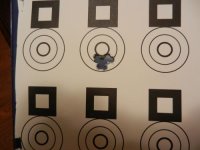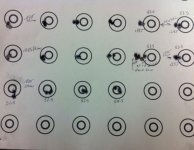adamsgt
Jerry Adams
Someone referenced a ladder test here recently and that inspired me to try one. Hadn't done one before. I was also trying out my chronograph that interfaced with my laptop to see how that worked. I loaded 10 rounds for my 6 Beggs LV gun. Use LT-32 powder and Berger column bullets. I started at 25.6 grains of LT-32 and went up .2 grains at a time to 27.4 grains. I'm not sure what I can learn from this except that 100 yds is probably too short a distance to get meaningful results. Comments gratefully accepted.




